Mechanical Behavior of Laminated Glass Polymer Interlayer Subjected to Environmental Effects
Abstract
1. Introduction
2. Experiments
2.1. Polymeric Interlayer Materials
2.2. Testing Matrix
3. Environmental Effects
3.1. Water Immersion
3.2. Environmental Chamber Effects
4. Mechanical Testing
Specimen Preparation
5. Static Testing Setup
5.1. Drop Weight Testing Equipment
5.2. Data Processing
6. Experimental Results Interlayer Tests
- Term1 describes the material state, and it can be V for the virgin interlayer or C for cured/processed interlayer;
- Term2 describes the interlayer type, and it can be P for PVB, E for EVA, and S for SG5000;
- Term3 will describe the test type, and it can be S for Quasi-Static tests and D for dynamic tests;
- Term4 will describe the type of the environmental effect; it can be E0 for the control group or E1, E2, E3, and E4.
6.1. Control Group (E0)
6.2. Humidity—Water Immersion (E1)
6.3. Constant Temperature—60 °C (E2)
6.4. Cycle Temperature with Constant Low Humidity (E3)
6.5. Cyclic Temperature and Humidity (E4)
6.6. Comparison between Different Environmental Effects
7. Conclusions
- The E4 effect most significantly impacts the quasi-static behavior of processed PVB resulting in a decrease in failure stress, failure strain, and toughness;
- The E1, E2, and E3 effects cause softening of the processed PVB and a decrease in failure stress. The responses associated with E1–E3 effects showed lower stress at the same strain values as the E0 control response;
- The environmental effects on the quasi-static response of processed EVA are less significant than the effects on the responses of PVB and SG5000;
- All four environmental effects (E1–E4) caused softening behavior of the EVA resulting in a decrease in failure stresses and negligible impacts on failure strains;
- For SG5000, all four environmental effects (E1–E4) caused a decrease in stiffness in the initial region before pseudo-yielding;
- The E1–E4 effects cause a decrease in failure stress, failure strain, and failure stress relative to the E0 control of the SG5000. The E4 effect impacts the initial region most significantly, while the E1 effect impacts the total response most significantly;
- It can be concluded that ethylene-vinyl acetate represented by EVGARD EVA products is the most resistive product for the environmental effects, while ionomer represented by the Kuraray SG5000 product is the most affected polymer.
Author Contributions
Funding
Institutional Review Board Statement
Informed Consent Statement
Data Availability Statement
Conflicts of Interest
References
- Saad, G.R.; El-Shafee, E.; Sabaa, M.W. Dielectric and Mechanical Properties in the Photodegradation of Poly(Vinyl Butyral) Films. Polym. Degrad. Stab. 1995, 47, 209–215. [Google Scholar] [CrossRef]
- Andreozzi, L.; Briccoli Bati, S.; Fagone, M.; Ranocchiai, G.; Zulli, F. Weathering Action on Thermo-Viscoelastic Properties of Polymer Interlayers for Laminated Glass. Constr. Build. Mater. 2015, 98, 757–766. [Google Scholar] [CrossRef]
- Serafinavicius, T.; Lebet, J.P.; Louter, C.; Kuranovas, A.; Lenkimas, T. The Effects of Environmental Impacts on Durability of Laminated Glass Plates with Interlayers (SG, EVA, PVB). In Challenging Glass 4 and COST Action TU0905 Final Conference; CRC Press: Boca Raton, FL, USA, 2014. [Google Scholar]
- Delincé, D.; Belis, J.; Zarmati, G.; Parmentier, B. Structural Behaviour of Laminated Glass Elements—A Step towards Standardization. In Proceedings of the Glass Performance Days 2007, Tampere, Finland, 15–18 June 2007. [Google Scholar]
- Butchart, C.; Overend, M. Influence of Moisture on the Post-Fracture Performance of Laminated Glass. In Proceedings of the Glass Performance Days 2013, Tampere, Finland, 13–15 June 2013. [Google Scholar]
- Weller, B.; Kothe, M. Ageing Behaviour of Polymeric Interlayer Materials and Laminates. In Proceedings of the Glass Performance Days, Tampere, Finland, 16–17 June 2011. [Google Scholar]
- Ensslen, F. Tragverhalten von Bewitterten Verbund-Sicherheitsglas-Scheiben. Stahlbau 2007, 76, 582–590. [Google Scholar] [CrossRef]
- Antolinc, D. Three-Point Bending Test of Laminated Glass with PVB and EVA Interlayers at Elevated Temperature. In Challenging Glass 7 Final Conference; Ghent University: Ghent, Slovenia, 2020. [Google Scholar]
- Martín, M.; Centelles, X.; Solé, A.; Barreneche, C.; Fernández, A.I.; Cabeza, L.F. Polymeric Interlayer Materials for Laminated Glass: A Review. Constr. Build. Mater. 2020, 230, 116897. [Google Scholar] [CrossRef]
- Sahmani, S.; Fattahi, A.M. Size-Dependent Nonlinear Instability of Shear Deformable Cylindrical Nanopanels Subjected to Axial Compression in Thermal Environments. Microsyst. Technol. 2017, 23, 4717–4731. [Google Scholar] [CrossRef]
- Zhang, X.; Liu, H.; Maharaj, C.; Zheng, M.; Mohagheghian, I.; Zhang, G.; Yan, Y.; Dear, J.P. Impact Response of Laminated Glass with Varying Interlayer Materials. Int. J. Impact. Eng. 2020, 139, 103505. [Google Scholar] [CrossRef]
- Centelles, X.; Martín, M.; Solé, A.; Castro, J.R.; Cabeza, L.F. Tensile Test on Interlayer Materials for Laminated Glass under Diverse Ageing Conditions and Strain Rates. Constr. Build. Mater. 2020, 243, 118230. [Google Scholar] [CrossRef]
- Biolzi, L.; Cattaneo, S.; Orlando, M.; Piscitelli, L.R.; Spinelli, P. Constitutive Relationships of Different Interlayer Materials for Laminated Glass. Compos. Struct. 2020, 244, 112221. [Google Scholar] [CrossRef]
- Biolzi, L.; Cattaneo, S.; Orlando, M.; Piscitelli, L.R.; Spinelli, P. Post-Failure Behavior of Laminated Glass Beams Using Different Interlayers. Compos. Struct. 2018, 202, 578–589. [Google Scholar] [CrossRef]
- El-Shami, M.M.; Norville, S.; Ibrahim, Y.E. Stress Analysis of Laminated Glass with Different Interlayer Materials. Alex. Eng. J. 2012, 51, 61–67. [Google Scholar] [CrossRef]
- Hidallana-Gamage, H.D.; Thambiratnam, D.P.; Perera, N.J. Influence of Interlayer Properties on the Blast Performance of Laminated Glass Panels. Constr. Build. Mater. 2015, 98, 502–518. [Google Scholar] [CrossRef]
- Liu, J.-C.; Yang, S.-G.; Yang, Y.; Fang, Q.; Rong, C.; Gan, J.-P. Experimental Study of the Dynamic Response of PVB Laminated Glass under Vented Explosion Loads of Methane–Air Mixtures. Int. J. Impact. Eng. 2020, 143, 103588. [Google Scholar] [CrossRef]
- Samieian, M.A.; Cormie, D.; Smith, D.; Wholey, W.; Blackman, B.R.K.; Dear, J.P.; Hooper, P.A. On the Bonding between Glass and PVB in Laminated Glass. Eng. Fract. Mech. 2019, 214, 504–519. [Google Scholar] [CrossRef]
- D’Ambrosio, G.; Galuppi, L.; Royer-Carfagni, G. A Simple Model for the Post-Breakage Response of Laminated Glass under in-Plane Loading. Compos. Struct. 2019, 230, 111426. [Google Scholar] [CrossRef]
- Galuppi, L.; Royer-Carfagni, G. The Post-Breakage Response of Laminated Heat-Treated Glass under in Plane and out of Plane Loading. Compos. B Eng. 2018, 147, 227–239. [Google Scholar] [CrossRef]
- López-Aenlle, M.; Noriega, A.; Pelayo, F. Mechanical Characterization of Polyvinil Butyral from Static and Modal Tests on Laminated Glass Beams. Compos. B Eng. 2019, 169, 9–18. [Google Scholar] [CrossRef]
- Zhao, C.; Yang, J.; Wang, X.; Azim, I. Experimental Investigation into the Post-Breakage Performance of Pre-Cracked Laminated Glass Plates. Constr. Build. Mater. 2019, 224, 996–1006. [Google Scholar] [CrossRef]
- Osnes, K.; Holmen, J.K.; Hopperstad, O.S.; Børvik, T. Fracture and Fragmentation of Blast-Loaded Laminated Glass: An Experimental and Numerical Study. Int. J. Impact Eng. 2019, 132, 103334. [Google Scholar] [CrossRef]
- Shitanoki, Y.; Bennison, S.J.; Koike, Y. Structural Behavior Thin Glass Ionomer Laminates with Optimized Specific Strength and Stiffness. Compos. Struct. 2015, 125, 615–620. [Google Scholar] [CrossRef]
- Morison, C. The Resistance of Laminated Glass to Blast Pressure Loading and the Coefficients for Single Degree of Freedom Analysis of Laminated Glass. Ph.D. Thesis, Cranfield University, Cranfield, UK, 2007. [Google Scholar]
- Hooper, P. Blast Performance of Silicone-Bonded Laminated Glass. Ph.D. Thesis, Imperial College London, London, UK, 2011. [Google Scholar]
- Nawar, M.; Salim, H.; Lusk, B.; Kiger, S. Modeling and Shock Tube Testing of Architectural Glazing Systems for Blast Resistance. J. Struct. Eng. 2015, 141, 4014174. [Google Scholar] [CrossRef]
- ISO 62; Plastics—Determination of Water Absorption. Vernier: Geneva, Switzerland, 2008.
- ASTM D570-98; Standard Test Method for Water Absorption of Plastics. ASTM International: West Conshohocken, PA, USA, 2018. [CrossRef]
- ASTM D638−10; Standard Test Method for Tensile Properties of Plastics. ASTM International: West Conshohocken, PA, USA, 2010.
- Nawar, M. Numerical Modeling and Experimental Evaluation of Laminated Glazing Systems and Material under Blast Loading. Ph.D. Thesis, University of Missouri, Columbia, MO, USA, 2016. [Google Scholar]
- Nawar, M.; Salim, H.; Newberry, M.; El-Sisi, A. High Strain Rate Response of Laminated Glass Interlayer Materials. Constr. Build. Mater. 2021, 299, 123934. [Google Scholar] [CrossRef]
- El-Sisi, A.; Newberry, M.; Knight, J.; Salim, H.; Nawar, M. Static and High Strain Rate Behavior of Aged Virgin PVB. J. Polym. Res. 2022, 29, 39. [Google Scholar] [CrossRef]
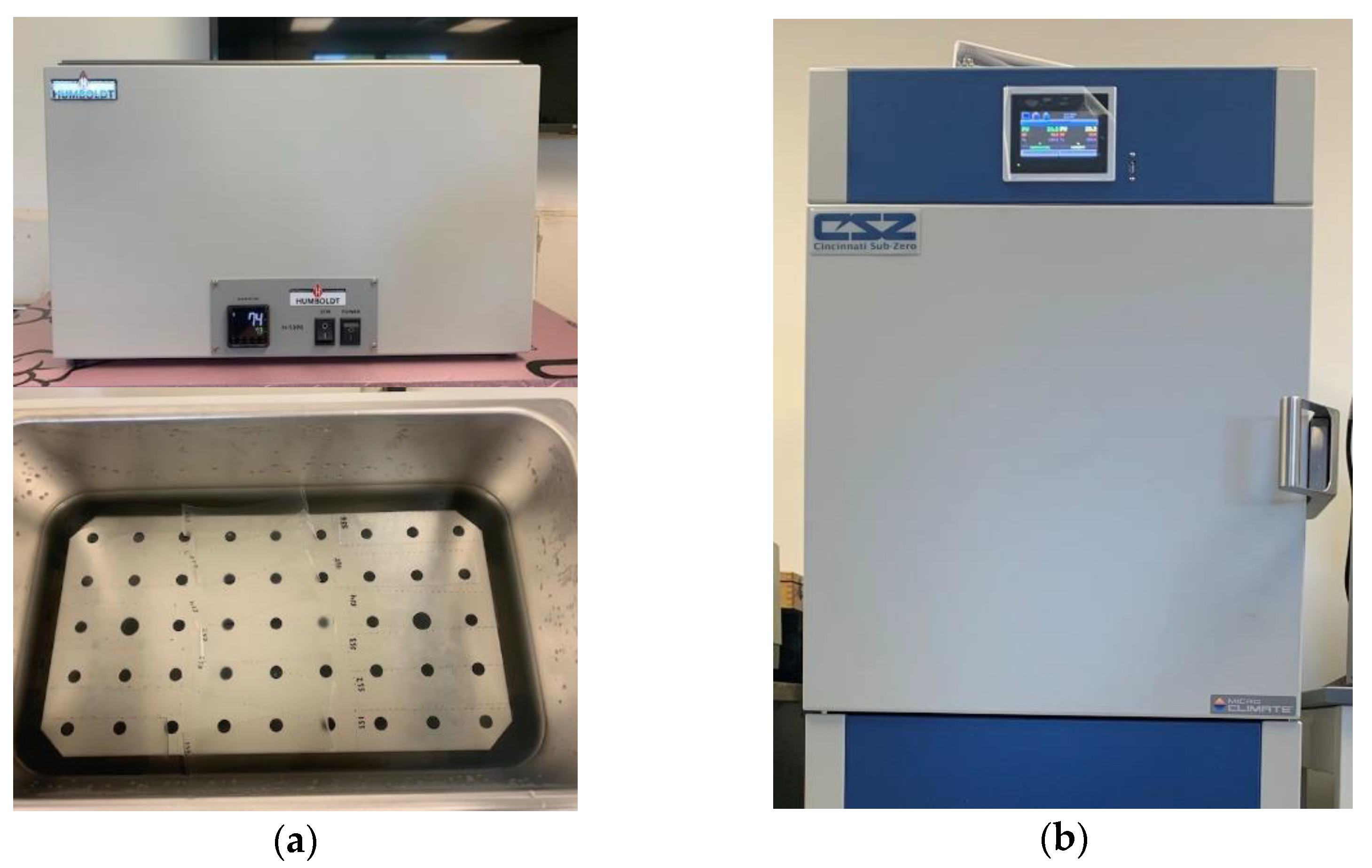



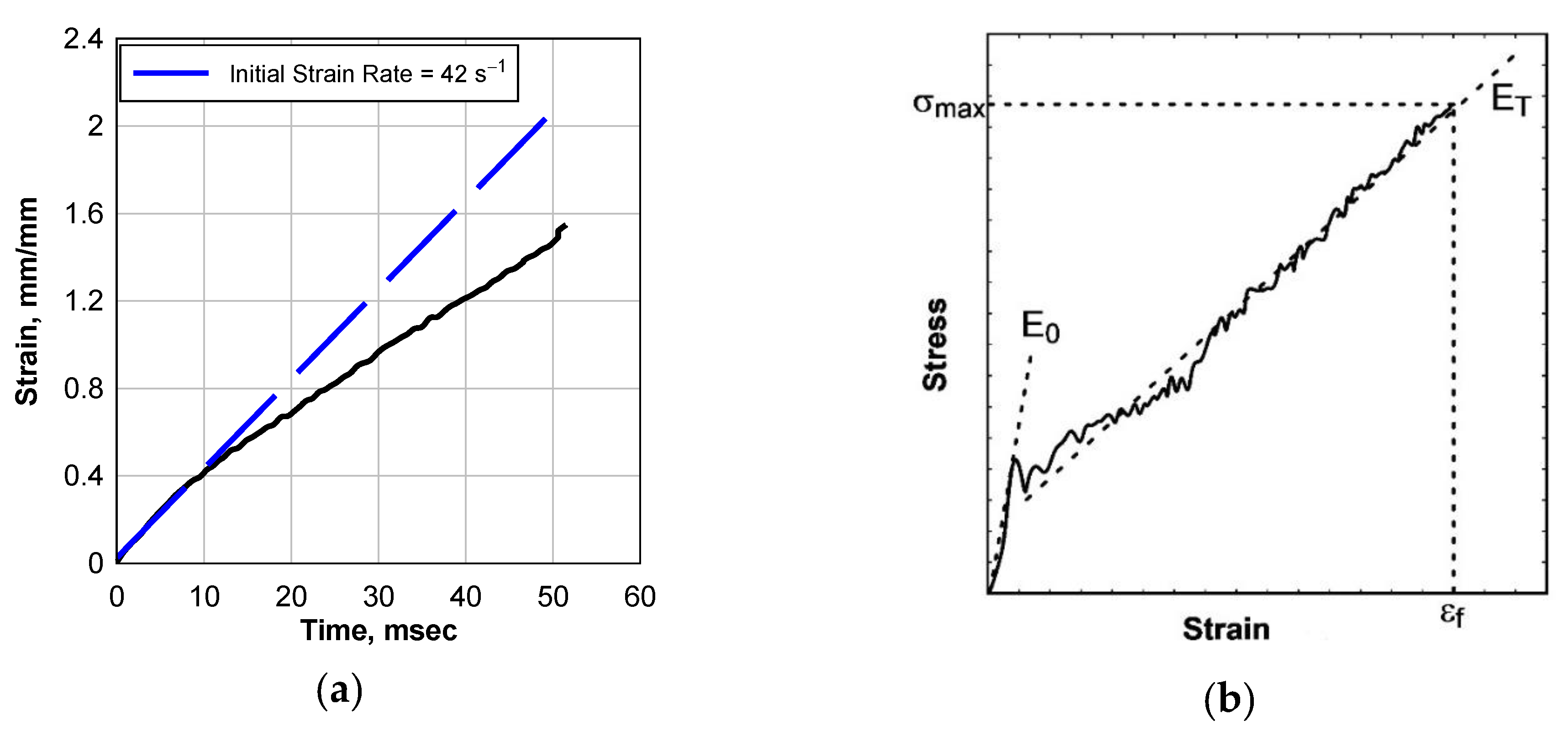

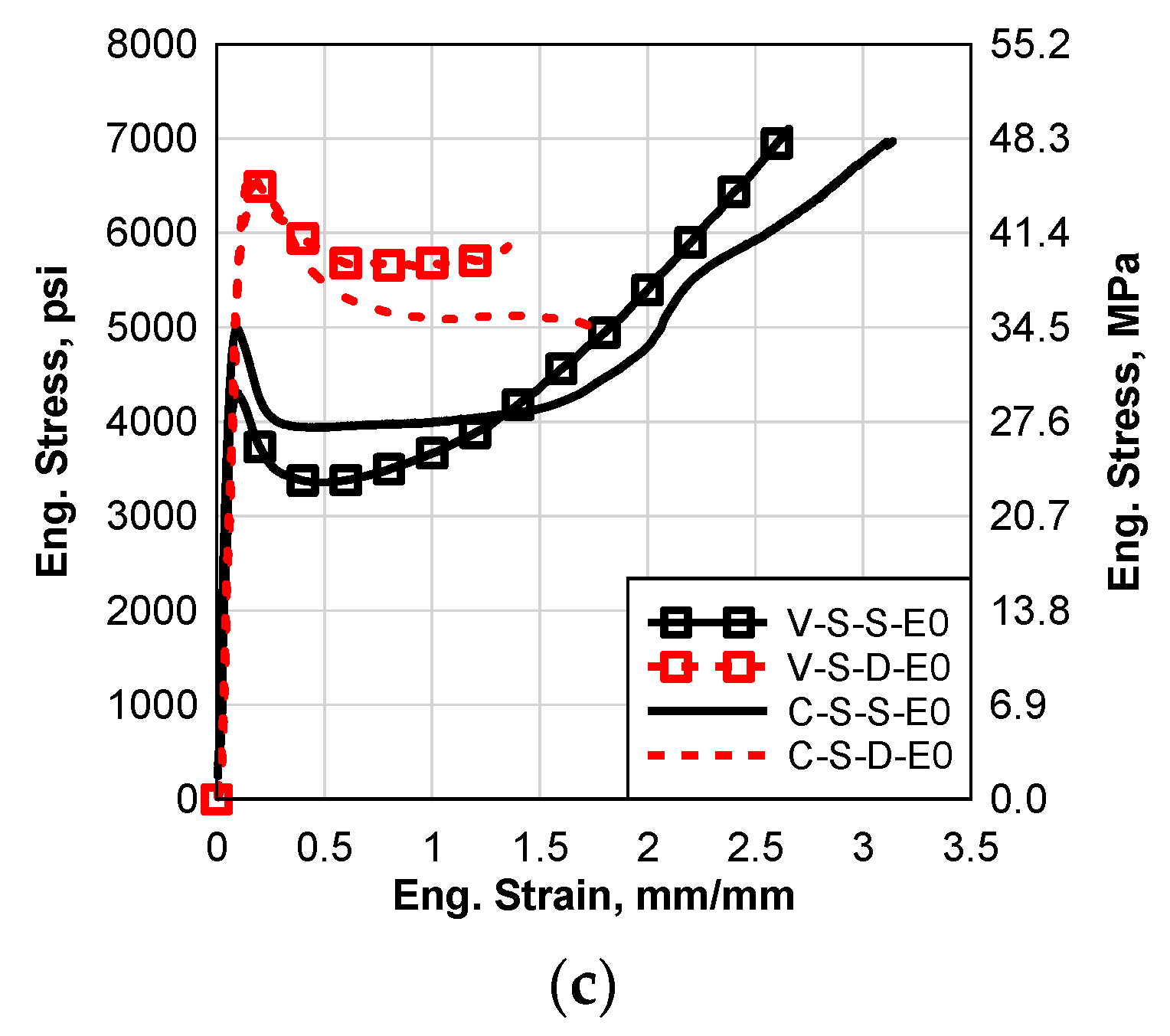


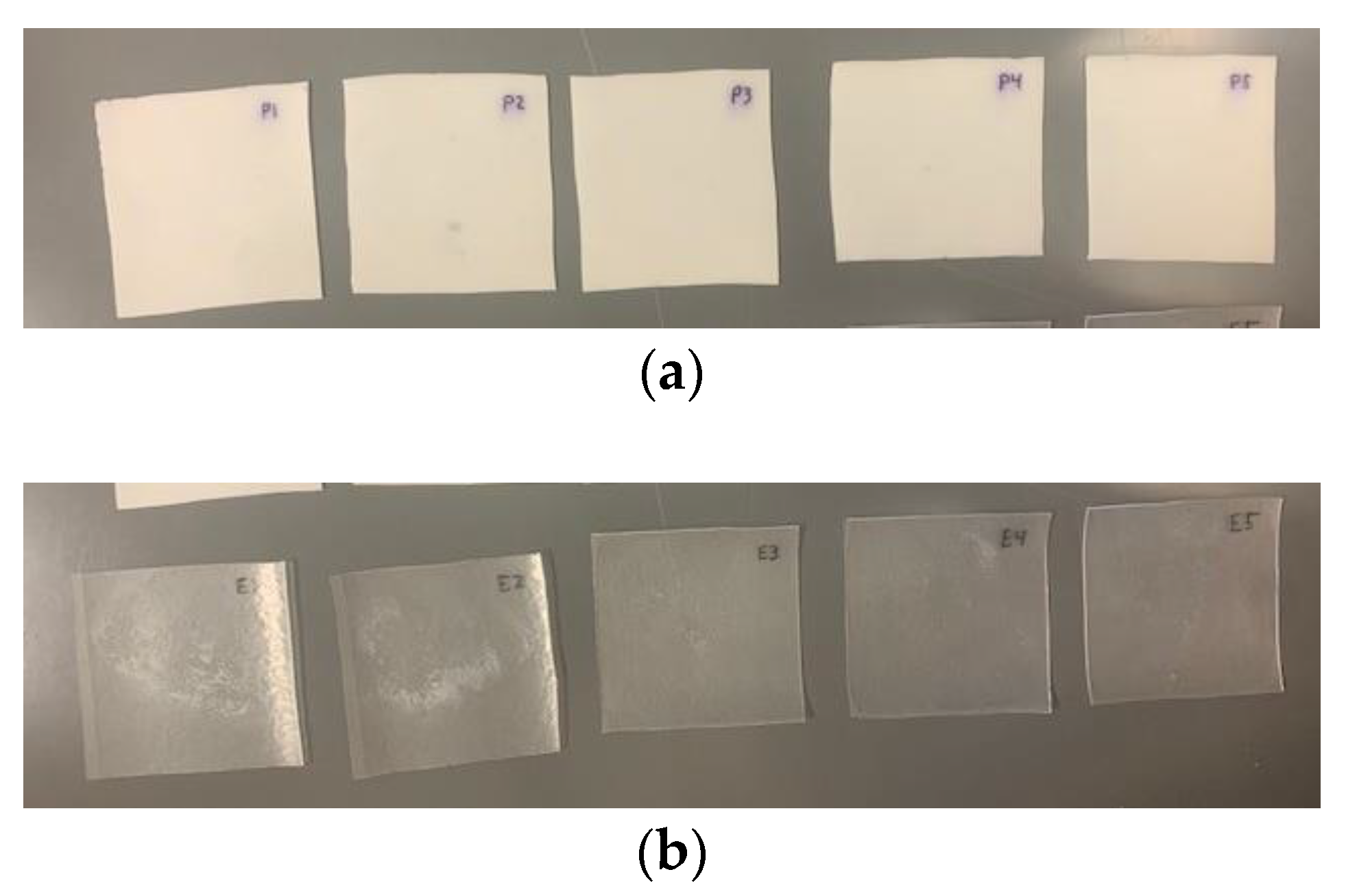


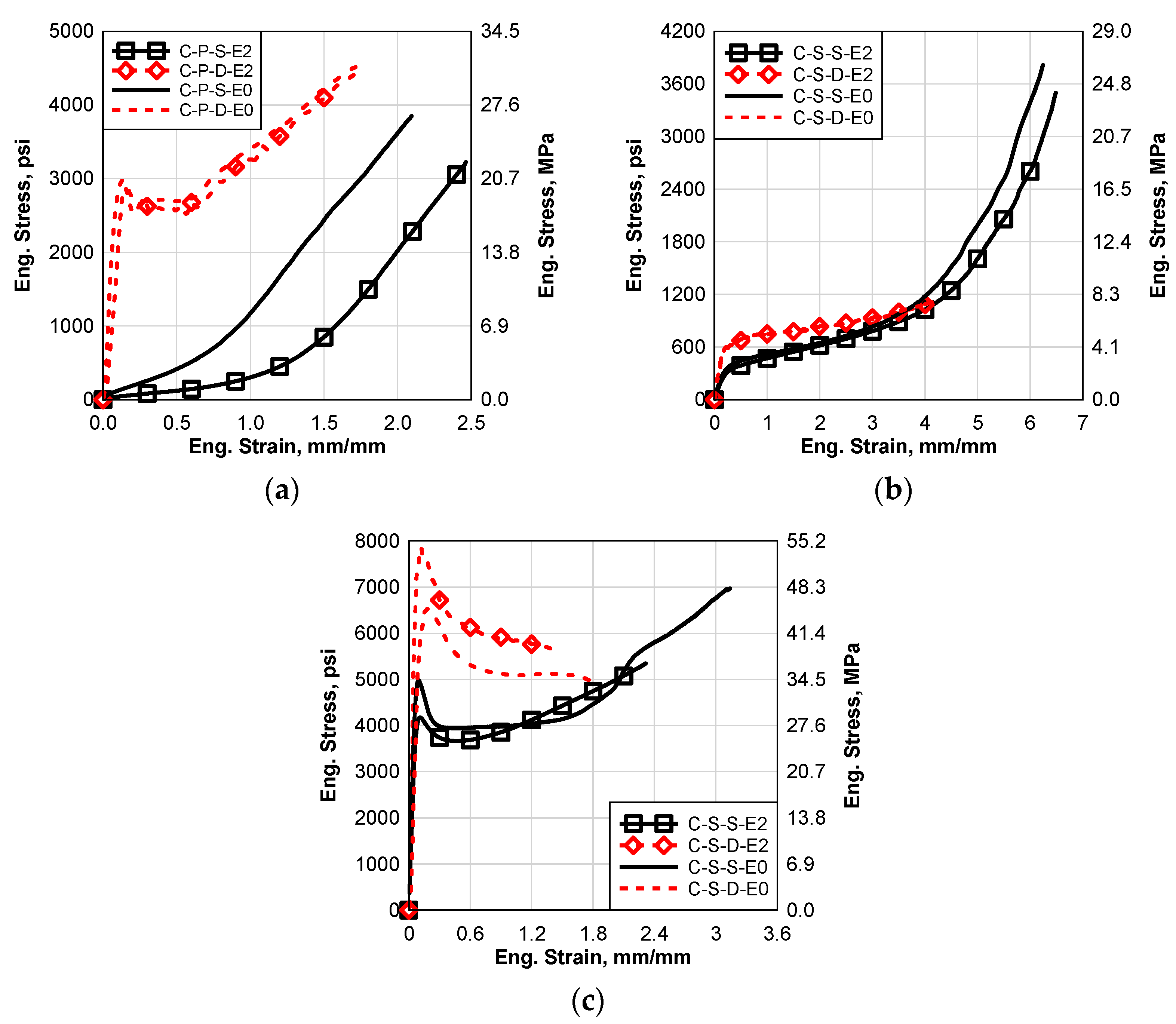



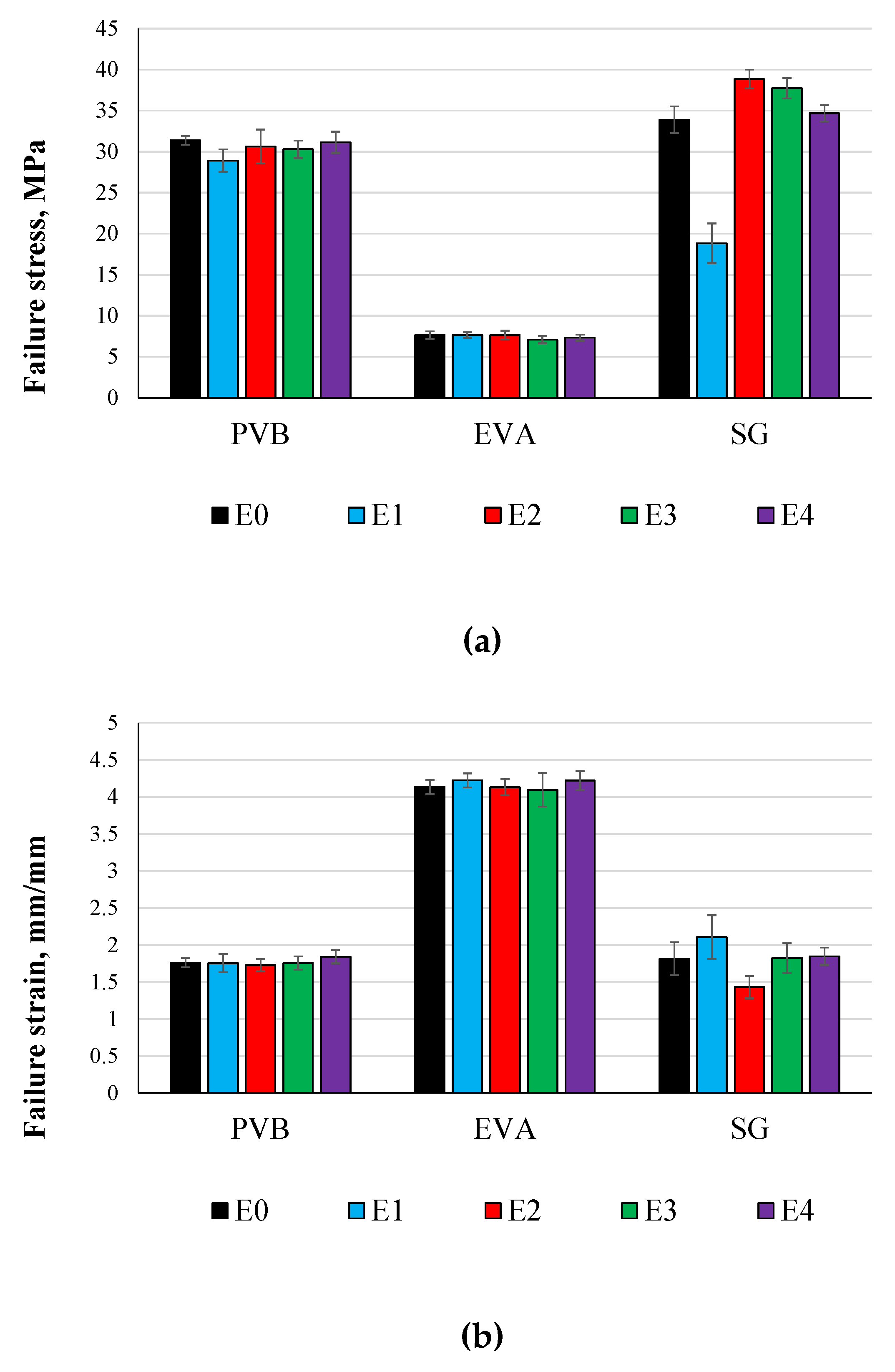
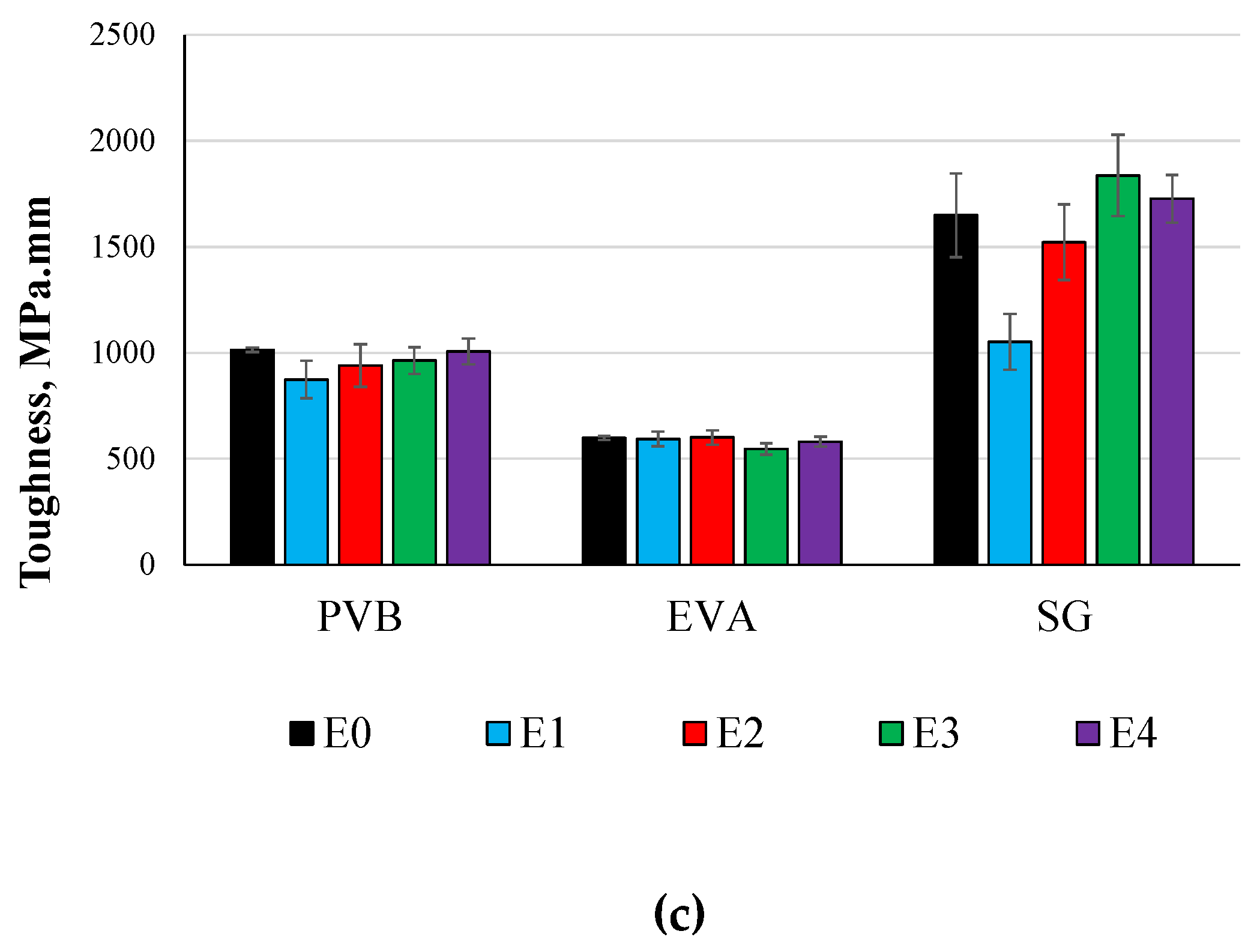
| Material | Manufacturer/Product | Thickness mm (in) | Material State |
|---|---|---|---|
| PVB | Saflex/Standard Clear | 0.76(0.03) | Virgin |
| PVB | Saflex/Standard Clear | 1.52 (0.06) | Cured/Processed |
| EVA | EVGuard | 0.76(0.03) | Virgin |
| EVA | EVGuard | 1.52 (0.06) | Cured/Processed |
| SG5000 | Kurary/ SG5000 | 0.89 (0.035) | Virgin and cured |
| Effects | Definitions | Duration | Standard |
|---|---|---|---|
| E0 | Control Group * | ~ | ~ |
| E1 | Humidity- Water Immerse | 169 h | ASTM D570 and ISO 62 |
| E2 | Constant Temp. 60 °C | 16 h | D3045 and ISO 12543 |
| E3 | Temp. Cycles- Low Humidity | 60 Cycles | |
| E4 | Temp. and Humidity Cycles | 20 h |
| Effects | Definitions | Temp, °C | Strain Rate, s−1 |
|---|---|---|---|
| E0 | Control Group * | 23 | Static, 45 |
| E1 | Humidity-Water Immerse | ||
| E2 | Constant Temp. 60 °C | ||
| E3 | Temp. Cycles-Low Humidity | ||
| E4 | Temp. and Humidity Cycles |
| Sample Name | Material State | Interlayer Type | Test Type |
|---|---|---|---|
| V-P-S | Virgin | PVB | Static |
| V-P-D | Virgin | PVB | Dynamic |
| C-P-S | Cured | PVB | Static |
| C-P-D | Cured | PVB | Dynamic |
| V-E-S | Virgin | EVA | Static |
| V-E-D | Virgin | EVA | Dynamic |
| C-E-S | Cured | EVA | Static |
| C-E-D | Cured | EVA | Dynamic |
| V-S-S | Virgin | SG | Static |
| V-S-D | Virgin | SG | Dynamic |
| C-S-S | Cured | SG | Static |
| C-S-D | Cured | SG | Dynamic |
Publisher’s Note: MDPI stays neutral with regard to jurisdictional claims in published maps and institutional affiliations. |
© 2022 by the authors. Licensee MDPI, Basel, Switzerland. This article is an open access article distributed under the terms and conditions of the Creative Commons Attribution (CC BY) license (https://creativecommons.org/licenses/by/4.0/).
Share and Cite
Knight, J.T.; El-Sisi, A.A.; Elbelbisi, A.H.; Newberry, M.; Salim, H.A. Mechanical Behavior of Laminated Glass Polymer Interlayer Subjected to Environmental Effects. Polymers 2022, 14, 5113. https://doi.org/10.3390/polym14235113
Knight JT, El-Sisi AA, Elbelbisi AH, Newberry M, Salim HA. Mechanical Behavior of Laminated Glass Polymer Interlayer Subjected to Environmental Effects. Polymers. 2022; 14(23):5113. https://doi.org/10.3390/polym14235113
Chicago/Turabian StyleKnight, Jonathan T., Alaa A. El-Sisi, Ahmed H. Elbelbisi, Michael Newberry, and Hani A. Salim. 2022. "Mechanical Behavior of Laminated Glass Polymer Interlayer Subjected to Environmental Effects" Polymers 14, no. 23: 5113. https://doi.org/10.3390/polym14235113
APA StyleKnight, J. T., El-Sisi, A. A., Elbelbisi, A. H., Newberry, M., & Salim, H. A. (2022). Mechanical Behavior of Laminated Glass Polymer Interlayer Subjected to Environmental Effects. Polymers, 14(23), 5113. https://doi.org/10.3390/polym14235113








